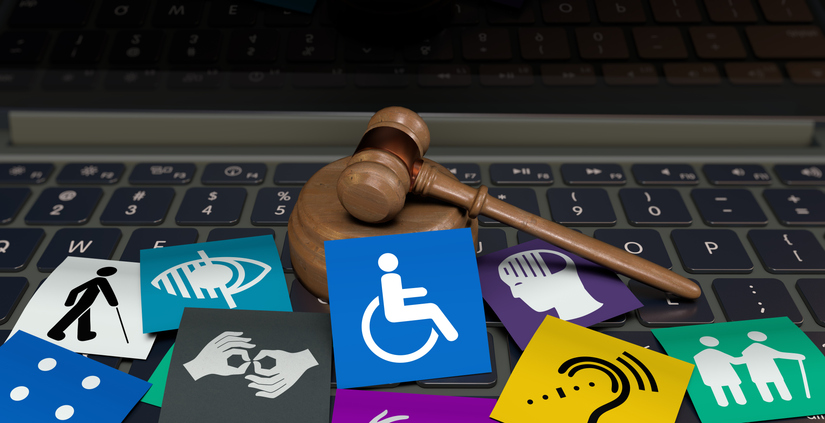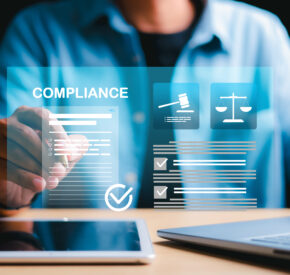The Legal Risks of Using an Overlay
The cost of not investing in real accessibility solutions

Website overlays have become more common in the past several years. An overlay is a short snippet of code with a pretty incredible claim: it promises to make your website compliant with accessibility laws and usable by people with disabilities.
If it sounds too good to be true, that’s because it is. It’s not possible to make a website compliant with accessibility standards like the Web Content Accessibility Guidelines (WCAG) using an overlay at this time. Instead, overlays serve as a way for companies to “virtue signal” and provide a “quick fix” without addressing underlying accessibility issues, according to Michael Zullo, lawyer with Duane Morris LLP and board member with the American Association for People with Disabilities (AAPD). Instead of using flawed overlay solutions, businesses should focus on accessibility training and consultation. This approach addresses real usability issues. It improves outcomes for current and potential customers and employees. Plus, it reduces legal risks.
The fact is, many people with disabilities already have the accessibility features and tools they need on their phones, tablets, and computers. They need websites and apps to be accessible with these tools. For many people with disabilities, overlays get in the way of existing accessibility tools. “When you have individuals who have assistive technologies to navigate websites, and a company goes and throws a quick solution on the website, there’s going to be genuine frustration,” notes Zullo. You can prevent user frustration by proactively addressing accessibility problems.
The interactions with assistive tech have led to a series of lawsuits by consumers against companies using overlays. Below, we take a look at three key lawsuits and what they mean for the future of web accessibility.
LightHouse et al vs. ADP, Inc (2022)
Case Overview
LightHouse for the Blind is a nonprofit that sued ADP, a payroll company. They claimed ADP’s HR platform, Workforce Now, was not accessible for blind employees. Workforce Now had an overlay, but still presented digital accessibility challenges. Employees who were blind or had low vision had to ask sighted colleagues for help with personal HR tasks, like signing up for health insurance.
Case Resolution
This case entered into structured negotiations, a process of mutual cooperation that resulted in a settlement. ADP stopped using the overlay. They also agreed to achieve “substantial compliance” with WCAG 2.1 in two years for their website and mobile app. ADP also agreed to hire an outside accessibility expert, provide training to staff who work directly with blind and low-vision customers, and create and adopt an accessibility policy for its website and mobile app.
Of note, the agreement between Lighthouse and ADP says that a website or mobile app is “accessible” if “blind and low vision individuals have independent access to the same information and equivalent ease of use…as sighted individuals.” In this agreement, “‘overlay’ solutions…will not suffice to achieve accessibility.”
Chax Perspective
This case settlement says that overlays alone do not make a website or mobile app accessible, especially for blind or low vision users. The outcomes of cases like these demonstrate the importance of hands-on accessibility expertise and doing it right the first time. Chax specializes in training your team to implement lasting, compliant solutions, without relying on quick fixes.
Murphy vs. Eyebobs (2021)
Case Overview
Anthony Murphy, a consumer, sued Eyebobs, an eyewear company, under Title III of the ADA. Murphy said that he, as a blind person, could not access Eyebobs’ website and digital properties. Murphy sued not only for himself, but for blind and low-vision people as a class. At the time, Eyebobs was using an overlay to try to make their website accessible.
Case Resolution
Eyebobs and Murphy settled. Eyebobs agreed that the U.S. portion of their website would be accessible according to WCAG 2.1 standards within 2 years. Eyebobs agreed to several additional steps, including hiring an accessibility consultant, forming an internal accessibility team, and providing staff training. The settlement includes all Eyebobs digital properties, including websites and mobile apps.
Chax Perspective
Similar to the Lighthouse case, the Eyebobs settlement confirms that website accessibility requires hands-on expertise. Eyebobs was required to hire and train people to make their digital properties accessible. The statement also shows that individuals can use Title III of the ADA to sue for website accessibility with success. Finally, it’s noteworthy that this was a class action suit on behalf of all blind and disabled people.
Quezada vs. US Wings
Case Overview
Jose Quezada, a consumer, sued US Wings, a jacket company, under the ADA and the NYC Human Rights Law. Quezada is legally blind, uses a screenreader, and the US Wings website wasn’t accessible to him. The website uses an overlay, and the overlay didn’t work with his screenreader. US Wings received audit statements from the overlay company “confirming” they were in compliance with WCAG standards. However, Quezada received statements from a third-party auditor showing the US Wings site was not compliant.
Case Status
No public updates have come since December 2021. That’s when the U.S. District Court for the Southern District of New York denied the US Wings motion to dismiss the case. The court emphasized that the burden of proof for demonstrating accessibility lies with US Wings, which had not shown that it had “undoubtedly fixed accessibility issues.” The decision also referenced prior lawsuits involving the same overlay provider.
After the ruling, a class action lawsuit was filed in the same court against accessiBe. This is the overlay company used by US Wings. The lawsuit claims that accessiBe misrepresented how effective its AI tools are in meeting the Americans with Disabilities Act (ADA) and the Web Content Accessibility Guidelines (WCAG). Though Quezada and US Wings are not part of this class action, their case often comes up in discussions about the limits of accessiBe’s overlay technology.
Tangentially related, in April 2025, The Federal Trade Commission (FTC) approved a final consent order against accessiBe, prohibiting the company from making misleading claims and requiring it to pay a $1 million fine.
Chax Perspective
In a lawsuit, both sides can gather evidence to prove or disprove WCAG compliance. However, the defendant carries the burden of proof. Of note, this is one of the first overlay lawsuits to be brought not only under a federal law but also a local equal access or human rights law. As this case continues to make its way through the court system, we anticipate further legal insights about digital accessibility and the use of overlays.
Don’t risk your digital accessibility and legal compliance strategy by relying on overlays. These cases show that meeting web accessibility standards needs real human skill and focused effort. Whether you’re a small business or a large organization, training your team is essential. Chax Training and Consulting offers expert-led workshops and tailored programs designed to equip teams of any size with the tools, knowledge, and confidence to build and maintain accessible digital experiences. It’s the right investment for your business, your users, and a more inclusive web. Get started today with Chax’s human-centered accessibility services, and let us support your team on the path to lasting digital inclusion.





